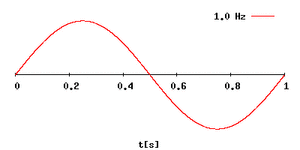Hertz facts for kids

The hertz (Hz) is a special unit that helps us measure frequency. Frequency tells us how often something happens in one second. If something has a frequency of 1 hertz, it means it happens exactly once every second.
Think about music: The note Middle C on a piano vibrates about 262 times each second. So, its frequency is 262 Hz. These fast vibrations are what we hear as the sound of Middle C.
Humans can hear sounds with frequencies between 20 Hz and 20,000 Hz. Owls, for example, hear a different range, from 200 Hz to 12,000 Hz. The hertz unit is named after a German scientist named Heinrich Rudolf Hertz.
Bigger Hertz Units
Sometimes, frequencies are very high, so we use bigger units to make them easier to talk about. Just like 1000 grams make 1 kilogram, 1000 hertz make 1 kilohertz.
Here's how the bigger units work:
| Unit | What it means |
|---|---|
| Kilohertz (kHz) | 1,000 Hz |
| Megahertz (MHz) | 1,000 kHz (or 1,000,000 Hz) |
| Gigahertz (GHz) | 1,000 MHz (or 1,000,000,000 Hz) |
| Terahertz (THz) | 1,000 GHz |
| Petahertz (PHz) | 1,000 THz |
| Exahertz (EHz) | 1,000 PHz |
| Zettahertz (ZHz) | 1,000 EHz |
| Yottahertz (YHz) | 1,000 ZHz |
Hertz in Everyday Life
The hertz unit is used in many different areas:
- The Earth spins around once every 24 hours. This is a very slow frequency, about 12 microhertz (which is much, much smaller than 1 Hz).
- In computers and electronics, hertz is used to measure how fast a processor works. A faster processor has a higher hertz number.
- Amateur radio users in the United States use different frequencies, often between 1.8 and 1300 MHz.
- Air traffic control uses frequencies between 3 and 25 MHz, and also between 108 and 136 MHz, to talk to airplanes.
- Another musical example: The note middle G (G4) has a frequency of 392 Hz.
Images for kids
See also
 In Spanish: Hercio para niños
In Spanish: Hercio para niños


